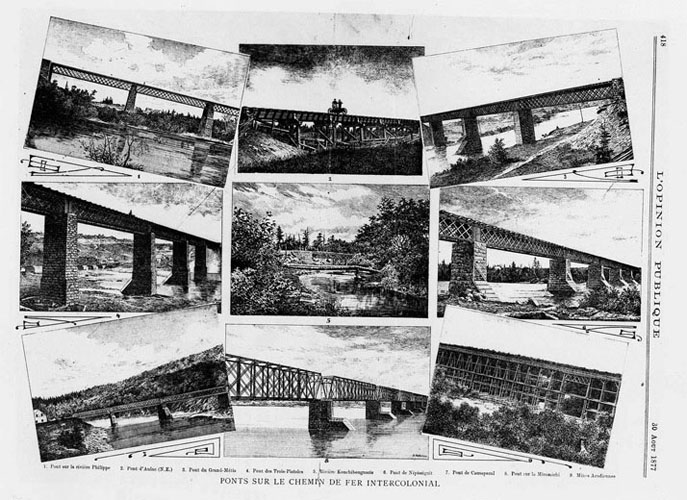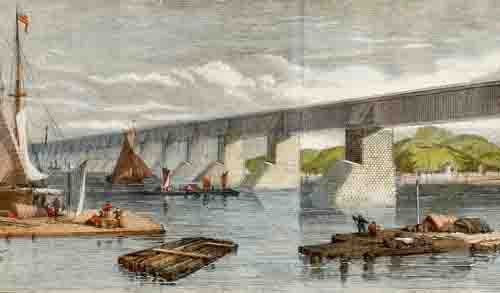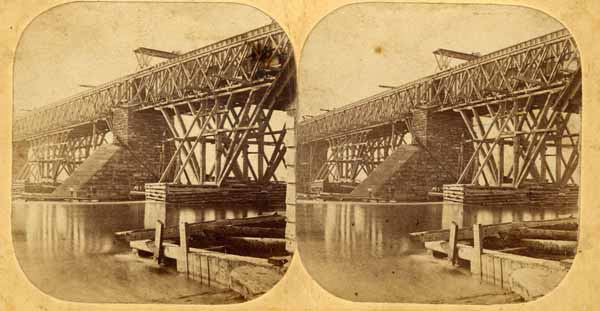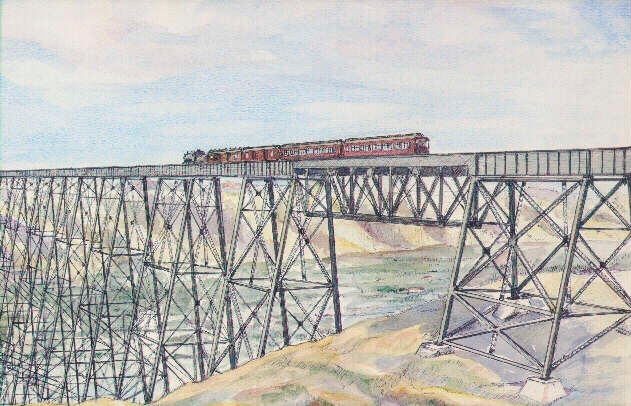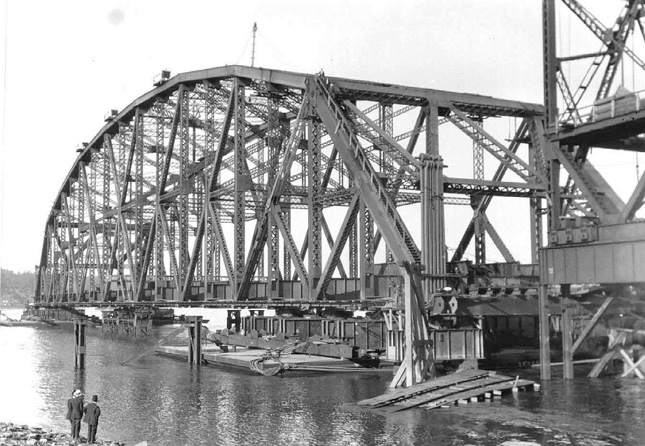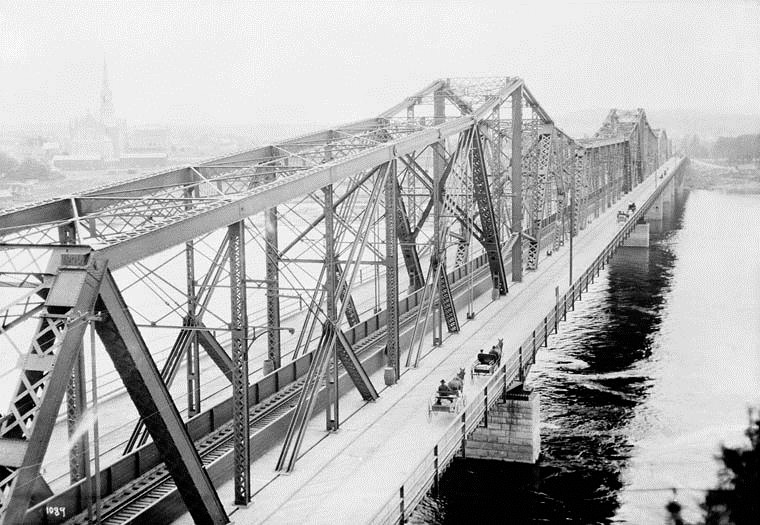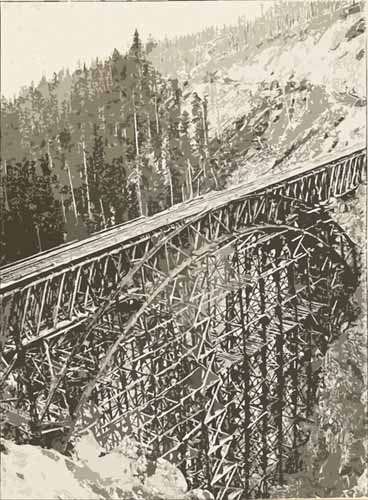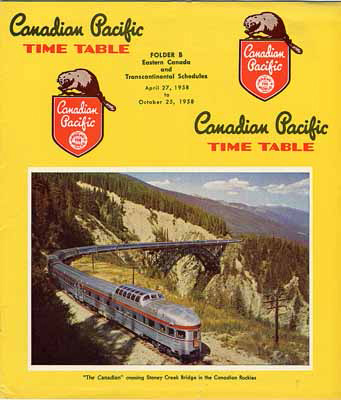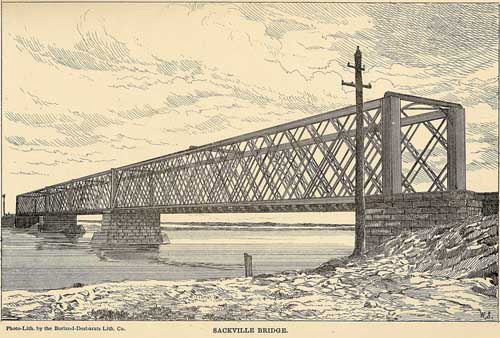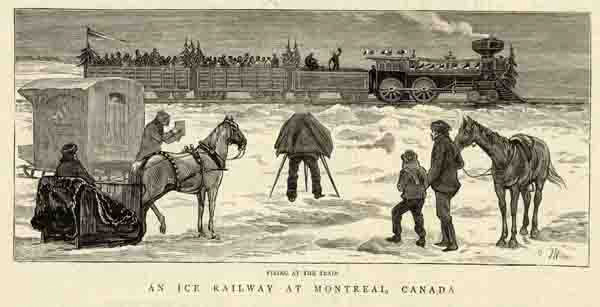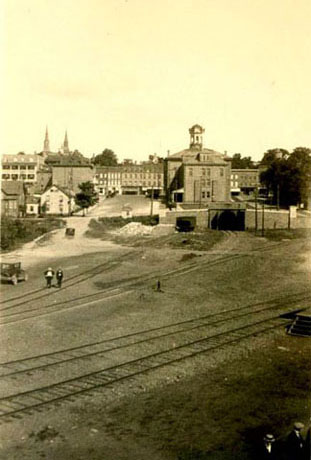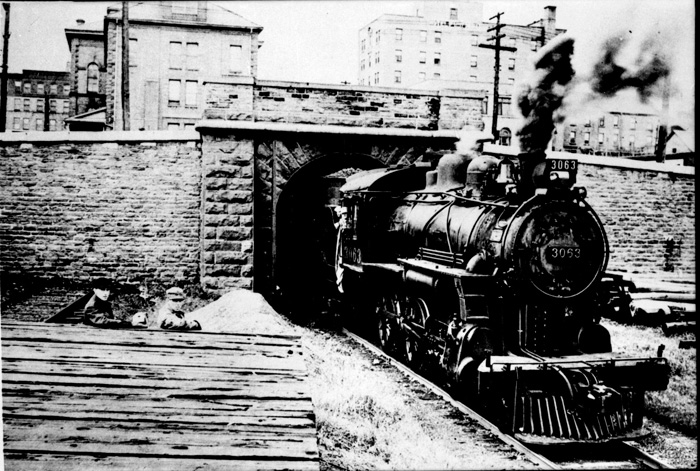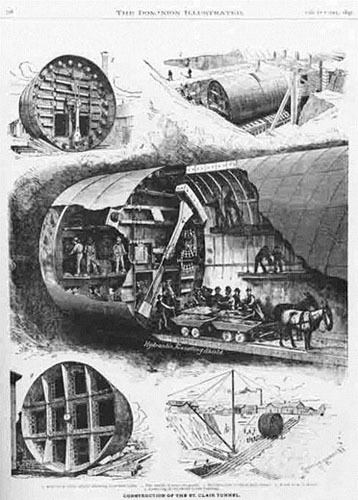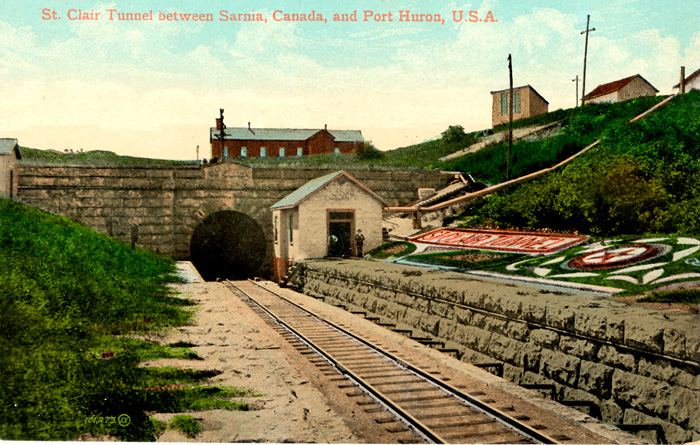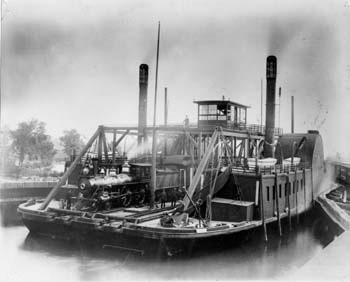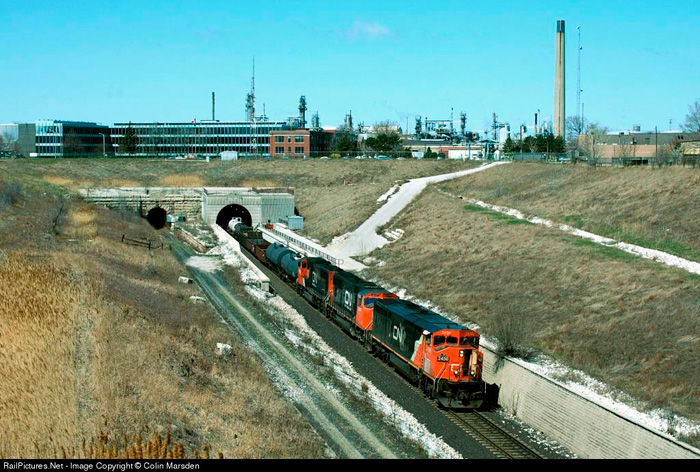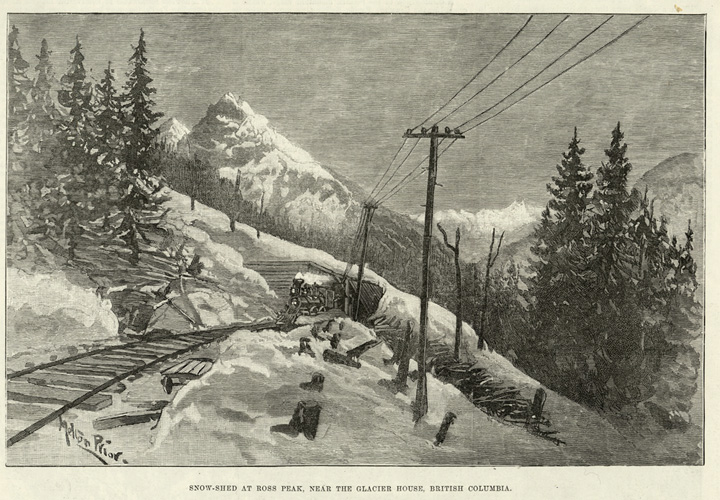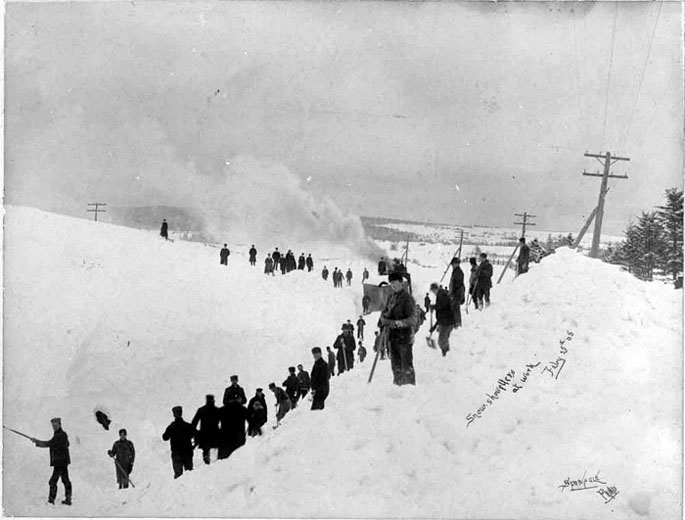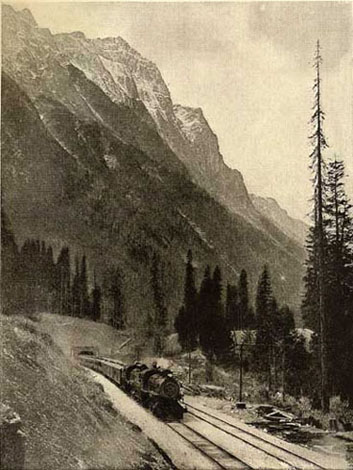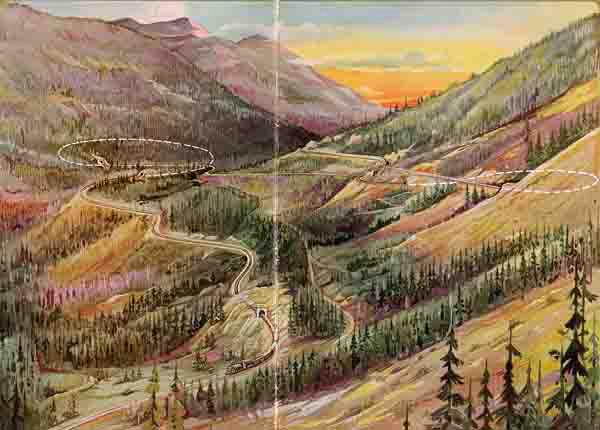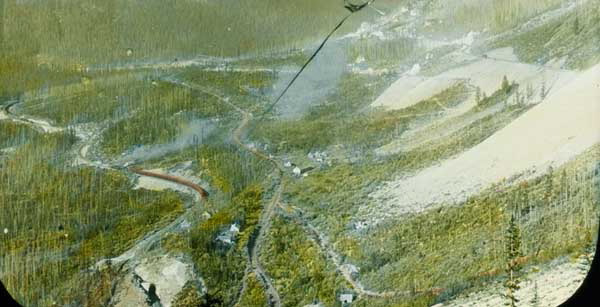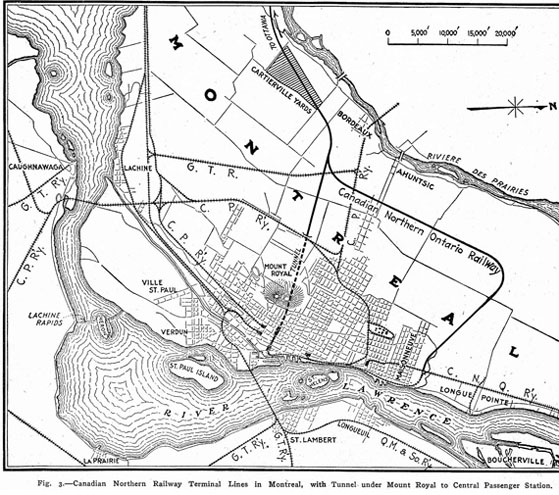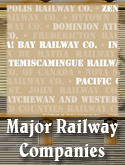Engineering in action
The geography of Canada presented the railway companies with major challenges. To connect the country, they had to go through or over mountain ranges, waterways and canyons. They also had to avoid long, costly detours and grades in excess of 4% (a 4 metre rise over a 100 metre distance), which steam locomotives were unable to climb.
To achieve these objectives, engineers built many types of bridges and excavated tunnels through rock and clay. These structures needed to be solid as well as safe for the trains that used them. Canadian engineers successfully conquered these challenges, and their reputation spread around the world.
Connecting the country with railway bridges!
The earliest bridges built before the 19th century were constructed of timber cut from nearby forests. Canadian Pacific later rebuilt these bridges with steel, a stronger material with a long life.
Here are some of the many types of railway bridges found in Canada.
Tubular bridges
Victoria Bridge, Québec
Completed in 1859, the Victoria Bridge was the first bridge connecting Montréal with the South Shore and, at its inauguration, the longest steel bridge in North America (2,009 metres). At the time, it was considered the Eighth Wonder of the World!
Construction of the Victoria Bridge was overseen by the Grand Trunk Railway and carried out by French-Canadian, English-Canadian, Irish and Scottish workers. In total, between 1,500 and 3,000 workers were employed—on the bridge itself as well as in workshops and stone quarries. To this day, CN trains still use the Victoria Bridge.
Trestle bridges
The Lethbridge Viaduct, Alberta
Construction of the Lethbridge Viaduct began in 1907 and was completed in 1909. Built by the Canadian Pacific Railway, the viaduct is still in operation today. It was built to shorten the existing route, reduce the number of curves and lessen the grade. The Lethbridge Viaduct is considered to be the world’s largest steel viaduct and the only one higher than 90 metres still in use.
Cantilever beam bridges
The Pont de Québec in Québec City and the Alexandra Bridge in Ottawa connecting Québec and Ontario
Construction of the Pont de Québec steel bridge started in 1904, but was marred by two collapses. The first killed more than 70 workers, mostly aboriginals from the Khanawake Mohawk reserve, who are renowned for their ability to work at great heights. The bridge was finally completed in 1917 and to this day boasts the longest cantilever beam bridge span in the world.
Completed in 1855, the Alexandra Bridge was the world’s first suspension bridge built for railway traffic. In 1886, the bridge was renovated with iron and steel to replace the original wood structure. It was a joint project of the Ottawa and Gatineau Railway and the Pontiac Pacific Junction Railway. Today, the Alexandra Bridge serves as a highway bridge.
Suspension bridges
Niagara Falls Bridge, Ontario
Built by the Great Western Railway, the Niagara Falls Suspension Bridge in Ontario was completed in 1855, providing direct access to the state of New York. Suspended by a system of steel cables, the bridge weighed 1,000 tons and included two decks, a major feat for the time. The upper deck was for trains, the lower for carts. Primarily intended to facilitate commercial trade, the bridge also helped to develop tourism for Niagara Falls. It remained in use until 1897, when it was replaced by a steel arch bridge built 90 metres above the valley floor.
Truss arch bridges
Stoney Creek Bridge, British Columbia
Stoney Creek Bridge was built in 1885, the year Canadian Pacific completed its trans-Canada railway. The original bridge was made of wood, but by 1896 it had been replaced with a steel structure. In its day, it was the highest bridge in the world! It remains in use and is one of the bridges most photographed by train tourists.
Truss bridges
Sackville, New Brunswick, railway bridge
The Intercolonial Railway was established to connect the maritime ports of Nova Scotia and New Brunswick to Québec and New England, in the United States. The company’s chief engineer, Sir Sandford Fleming, built all Intercolonial bridges of iron rather than wood. He wanted to ensure their durability from the outset and avoid any chance of bridges catching fire from the hot embers dropped by steam locomotives.
A chilly crossing: the railway ice bridge across the St. Lawrence!
Throughout history, ice on lakes and rivers has been used to travel from one shore to another. These ice bridges form naturally in winter and can be maintained to ensure the safe passage of people and goods. During the 1880s in the Montréal area, trains operated by small railway companies had to pay dearly to use the Victoria Bridge, owned by the powerful Grand Trunk Railway, which was not inclined to share its right of way.
From 1880 to 1883, rails and ties were therefore laid directly on the ice during the winter so that trains could cross between Montréal and Longueuil. From January until early March or April (depending on the thickness of the ice), a “small” 60-ton train would make the round trip. The total length of the railway ice bridge was 3,000 metres and, during the second winter of operation, nearly 1,200 cars used it to cross the St. Lawrence on ice!
Tunnelling under mountains and rivers!
Railway tunnels were built to overcome a number of problems:
- steep grades that made it dangerous to operate trains and caused accidents;
- areas susceptible to avalanches;
- expensive roundabout routes between destinations.
Brockville Tunnel, Ontario
The first railway tunnel excavated in Canada was the Brockville Tunnel in Ontario, 527 metres long. Constructed between 1854 and 1860 by the Brockville and Ottawa Railway, it provided access to the shores of the St. Lawrence River, where cargo hauled by trains, primarily wood, was transferred to boats. Later, the Canadian Pacific Railway acquired the tunnel and operated it until 1970.
St. Clair Tunnel and the Paul M. Tellier Tunnel under the St. Clair River in OntarioConstruction of the first underwater tunnel in North America began in 1889 and was completed in 1891. A Grand Trunk Railway initiative, the St. Clair Tunnel connected the cities of Sarnia (Ontario) and Port Huron (Michigan, U.S.A.).
The tunnel saved two hours of travel time, thereby reducing transportation costs. Before the tunnel was built, railcars were loaded onto ferries to cross the river. At the time of construction, the St. Clair Tunnel was an unparalleled achievement. Nearly two kilometres in length, it was excavated at a rate of close to 139 metres a month. In 1993, CN began construction of a new tunnel beside the existing one. Opened to traffic in 1994, it was renamed the Paul M. Tellier Tunnel in 2004 and continues to be used by cargo and passenger trains.
Connaught Tunnel, Rogers Pass, British Columbia
This eight-kilometre-long tunnel was excavated under Mount MacDonald between 1913 and 1916 to circumvent the dangerous Rogers Pass, which was prone to avalanches at numerous of sites. Every winter, up to 12 metres of snow would fall, interrupting train service for weeks, or even months, at a time.
Canadian Pacific Railway suffered heavy losses in terms of human lives and material resources in the treacherous pass. With the tunnel, CP train routes were shortened by nearly seven kilometres, while providing safe passage for trains and workers. When it opened, it was the longest railway tunnel in North America. It remains in use to this day.
Spiral Tunnels, Kicking Horse Pass, British Columbia
Before the Spiral Tunnels were built, extra locomotives had to be coupled at the head, middle and tail end of each train in order to climb the steep grade through Kicking Horse Pass.
Forced to reconsider its route through the pass, in 1907 Canadian Pacific opted to construct two helical (spiral) tunnels. The steep grade (4.5% or a rise of 4.5 metres over a distance of 100 metres) was reduced by half, to just 2.2%—a much more reasonable grade for a railway. Construction was completed in 1909. The two tunnels have a combined length of 1,883 metres and are still used by Canadian Pacific.
Tunnel under Mount Royal, Montréal (Québec)
Canadian Northern Railway began excavating this tunnel in 1912, but it would not be completed until 1916. The owners of the company, Sir William Mackenzie and Sir Donald Mann, wanted a direct link with their station in downtown Montréal. To finance the project, they purchased land at the north end of the tunnel to develop an exclusive avant-garde urban neighbourhood around a future train station. The history of what is now the Town of Mount Royal is intimately associated with construction of the tunnel.
In 1918, the first trains rolled through the tunnel under Mount Royal, which is 188 metres deep and 4,972 metres long. Excavated by workers using compressed-air drills, the tunnel was bored at a rate of nearly eight metres a day. Rock taken from the mountain was sent to a plant were it was crushed for reuse as ballast under railway tracks and by the construction industry. To avoid toxic fumes from steam locomotives, the entire tunnel was wired with electricity and electric locomotives were built to pull trains through it. Not long after the tunnel was completed, Canadian Northern Railway ceased operations and was absorbed in the creation of Canadian National Railways. Nowadays, commuter trains operated by Agence métropolitaine de transport use the tunnel.








